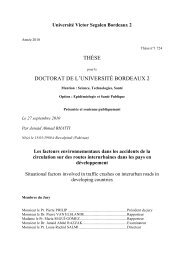You also want an ePaper? Increase the reach of your titles
YUMPU automatically turns print PDFs into web optimized ePapers that Google loves.
était fixé à 8.Nous avons illustré graphiquement <strong>le</strong>s résultats des estimations des fonctions de risquethéoriques et estimées, margina<strong>le</strong>s ou conditionnel<strong>le</strong>s.– La fonction de risque de base théorique est égal à λ 0h (t) = a h b a hh ta h−1 . El<strong>le</strong> peut s’interprétercomme la fonction de risque conditionnel<strong>le</strong> pour un effet aléatoire moyen(Z = E[Z] = 1).Nous avons estimé la fonction de risque de base correspondante sur une base desplines ̂λ 0h (t) et <strong>le</strong>s bandes de confiance de cette fonction.– La fonction de risque de base margina<strong>le</strong> théorique est éga<strong>le</strong> à :λ(t) =∫ ∞0hλ 0h (t)zg(z)dz =λ 0h (t)(1 + θΛ 0h (t)) = a hb a hh ta h−1(1 + θ(tb h ) a h )La fonction de risque de base margina<strong>le</strong> peut être estimée par deux estimateurs :oûλ(t) =̂λ 0h (t)(1 + θ ̂Λ 0h (t))̂λ(t) ∗ = λ ∗ 0h(t)où λ ∗ 0h (t) est la fonction de risque de base obtenue dans un modè<strong>le</strong> à risques proportionnels(sans effets aléatoires), par maximisation d’une vraisemblance pénalisée.
















